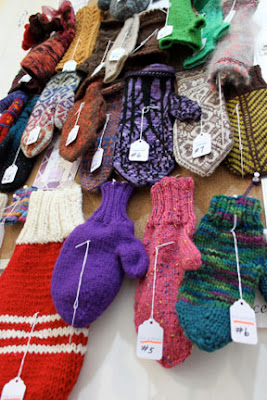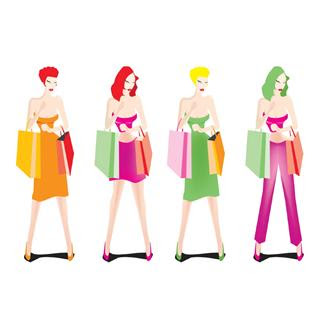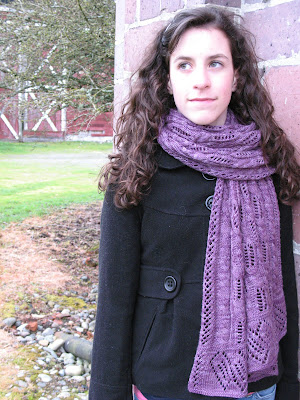Once a week I post interviews with interesting designers about their insights on their experience of working in the Knitting industry. I’ve noticed that every designer makes their living in a slightly different manner bringing their own unique presence to the Knitting world. You can find Genna here and here on Ravelry
Where do you find inspiration?
This is always the hardest question to answer! Often, it is the yarn itself. When I have been given a yarn to work with, or pick one out of interest, I often go through a process of swatching it out or pondering the colour or drape, and that tells me the kind of idea set I'm going to be working with. Sometimes, inspiration for the garment itself just comes out of the blue, when I'm not looking for it, and then I run off to find yarn that will work with that idea.
What is your favourite knitting technique?
I love cables, as is probably evident from the number of projects I have that use cable twists of various kinds. They are such an effective way to add both texture and structure to knitted garments, and once you get the hang of doing them I think it is just as easy as garter stitch - but always seriously impressive-looking to knitters and non-knitters alike!
Do you look at other designers' work or are you afraid that you will be influenced by their designs? The knitting community is so vibrant, particularly online, that if I avoided looking at other designers' work, I would probably have to stop using the Internet! I like designing for what interests me, and tend to be motivated more by those interests and desires more than anything else.
How do you feel about the so called controversy of "dumbing down" patterns for knitters?
Well, I suppose I didn't know there was a controversy about it! It is definitely a hard balance to strike, as a person who writes patterns. On the one hand, I believe very strongly that we are all capable and intelligent folks who don't always need absolutely everything spelled out for us all the time. I really enjoy going back to things like Elizabeth Zimmerman's patterns, where she gives guidelines and encouragement rather than specific row-by-row instructions. Any knitting pattern is an opportunity for the knitter to become a better knitter, and that has to happen because the knitter is engaged with it.
At the same time, all of us are busy folks. I love complexity in my design and knitting, but not all the time. Sometimes I need things to be simple or simplified, and clear step-by-step instructions help out with that. And I also know that I often offer designs with a bit of complexity in them, so if I didn't write out clear instructions, I'd have a hard time offering patterns! Thankfully in the world of PDF downloads, we aren't limited by word count, which is fantastic.
At the end of the day, I think knitters should strive for the same kind of balance - look for patterns that will challenge you and stretch your capabilities, and expect that there will be some styles or design techniques that will bit of a struggle at first, but the result is that you will be a better knitter. Challenge is a good thing.
How many sample/test knitters do you have working for you or do you do it all yourself? I do have a couple of test knitters that help me out, but it's likely that I'll be on the hunt for more in the next year. I knit all my designs myself, often as a first crack at it and as a partnering step to writing out the pattern and thinking through the instructions.
What impact has the Internet had on your business?
It is safe to say I wouldn't have a knitting design life without the Internet. Years ago I first started reading knitting blogs and encountered knitters who were working on their own patterns and projects, and it made me think I could do the same thing. Blogging was my first entry into the knitting Internet community and is a presence I am planning to keep for a while. It is a way for me to think and write about knitting and the knitting world, and one part of that is being able to report on my designs when I complete them and make them available to the world. My patterns are almost entirely available online, through Ravelry and Patternfish, so I wouldn't have much of a design career without the Internet, that is for sure! I like that these media are available for knitters in such a user-friendly fashion.
How do you maintain your life/work balance?
If I figure that out, I'll let you know!
But seriously, folks...Well, right now, I try to do a little bit of something every day. A bit of work, a bit of exercise, a bit of knitting (sometimes more than a bit), cooking and eating food I enjoy, a bit of procrastinating...And trust that things will get done. In achieving balance as a knitter and a knitting designer, I am committed to always having something on the needles that is not of my own design. I need to always be reminded that knitting is something I enjoy and something that I continue to learn from, and it helps to not always be in charge of all the decisions that go into every project I complete.
How do you deal with criticism? So far, at least, I have been lucky enough not to have too many complaints - or at least, not many have been directed at me! So I am hoping that is a good thing. But I try to take concerns seriously and address them one at a time. If a knitter is struggling with something in one of my patterns, I do my best to help her out and adjust the pattern for future use, if it might help. Still, none of us can please everyone all the time, and we all do the best we can.How long did it take for you to be able to support yourself? Knitting design isn't something I'm able to do to support myself, at least not at the present time. But I am continuing to work at it and grow my design portfolio, and am hoping to expand further in the coming year or two.
What advice would you give someone who wants to pursue a career in knitting?
Give it a try, keep going, and do what you enjoy.























